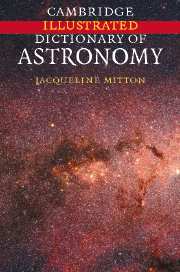Summary
RA Abbreviation for ➤ right ascension.
radar astronomy The use of radar for astronomy. Radar can be used to detect ➤ meteor showers, to measure distances to bodies in the solar system and determine their size and shape, and to map the surfaces of planets and moons. Radar signals transmitted by the 305-m (1000-foot) radio telescope at ➤ Arecibo Observatory have been used to map Venus and to characterize the size, shape and structure of ➤ asteroids. The ➤ Magellan spacecraft, placed in orbit around Venus, used ➤ synthetic aperture radar to map the planet's surface, which is concealed by opaque cloud, and the ➤ Cassini spacecraft used radar to study the surface of ➤ Titan. Radar is of fundamental importance for making precise measurements of distance within the solar system.
radial velocity The velocity of an object relative to an observer along the line of sight.
radiant The point on the celestial sphere from which the trails of meteors belonging to a particular ➤ meteor shower appear to radiate. Meteors entering Earth's atmosphere from a stream create trails that are almost parallel but perspective makes them seem to diverge from a point in the sky.
radiation belt A ring-shaped region around a planet where electrically charged particles (electrons and protons) are trapped and spiral around the direction of the magnetic field of the planet. The radiation belts surrounding the Earth are known as the ➤ Van Allen belts. Similar regions exist around other planets with magnetic fields, such as Jupiter.
- Type
- Chapter
- Information
- Cambridge Illustrated Dictionary of Astronomy , pp. 285 - 299Publisher: Cambridge University PressPrint publication year: 2007



